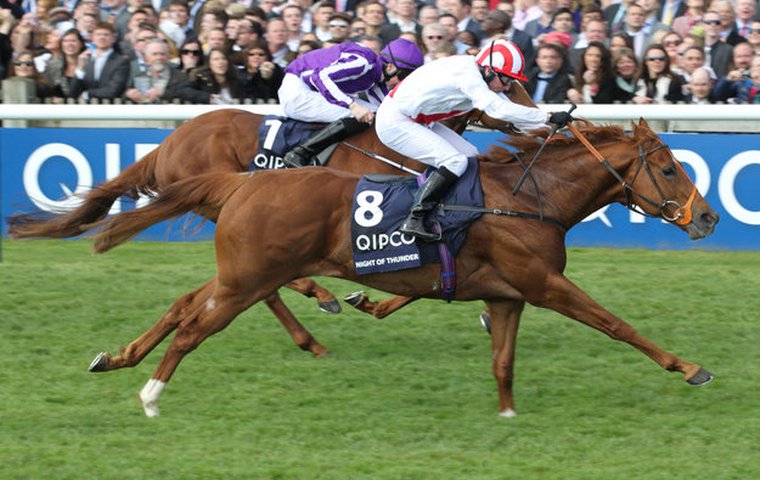
Simon Rowlands, head of international research and development at Timeform, looks through assessments of recent performances, as well as past renewals of the major Classics this weekend on either side of the Atlantic, and comes up with some clear conclusions.
My last article on these pages was headlined “Figures show it’s likely to be a high-quality 2000 Guineas.” While it might appear that prediction was overly confident, with 40-to-1-shot Night of Thunder winning a race in which the field split and less than a length covered the first three, there are a number of reasons to think otherwise.
Analysis of both overall and sectional times paints a positive picture, while there was a decent gap back to the fourth, and that fourth, Shifting Power, and the runner-up, Kingman, have run second and first, respectively, in the Irish 2,000 Guineas.
Night of Thunder’s form-based assessment of 125 in the race itself is slightly below a 10-year average bolstered by such good winners as Frankel and Dawn Approach, but the figures for the first three combined make it one of the deeper Guineas in recent times.
However, California Chrome’s win in the Kentucky Derby on the same day is fractionally better at 126 on Timeform ratings at this stage, and the colt’s subsequent win in the Preakness from Ride On Curlin (seventh at Churchill Downs) promises that the form at Churchill Downs will be franked.
The difference in abilities shown by the winners of the Kentucky Oaks and the 1,000 Guineas was much more clear-cut: With a form rating of 125, Untapable looks the best filly to have landed the former contest since Rachel Alexandra in 2009 and is fully 12 points clear of the Newmarket winner, Miss France. The principals in the Kentucky Oaks have yet to run since, but the runner-up, Lightning Thunder, has performed with credit – though been beaten more decisively by Marvellous – in the Irish 1,000 Guineas since.
There is a saying in Britain that “there is only one Derby – the one at Epsom – and all others are imitations,” something with which Americans and many others may not agree. The Derby – the original one, first run in 1780 – takes place on June 7, and again historical ratings can guide us as to what to expect.
As recently as the 1970s and 1980s, the Derby was flying high, with the Timeform rating of the winner averaging at 132. That average dropped to 127 in the 1990s and 2000s, and it is running at just 125 in the current decade. Workforce was a good winner in 2010, but the Derby could do with another of his ilk sooner rather than later to buck the otherwise downward trend.
By finishing a close third in the 2,000 Guineas at Newmarket Racecourse, Australia, the short-priced favourite for the Derby, has already surpassed the level of form shown by Ruler of The World in victory at Epsom 12 months ago. Australia’s rating of 123 is also in excess of the 10-year average for second (121.4) and third (119.2) at Epsom. If he runs his race, he has to be there or thereabouts.
Much as Australia turned up in what proved to be a strong Guineas, and ran well in defeat, it is at least possible that the Derby will take more winning than normal. Winners of the Derby tend to improve on previous form, and the likes of True Story (if putting a dull effort at York Racecourse behind him), Kingston Hill, and Australia’s stablemate Geoffrey Chaucer would not have to progress by very much to be major dangers.
The Derby is a unique event, and that term can definitely be used also to describe the Belmont Stakes, which will take place later the same day.
The average rating required to win the Belmont (123.4 over 10 years), is not quite as high as for the Kentucky Derby (126.0) or even the Preakness (124.6), but that is not the big issue here, of course. California Chrome is good enough to win the Belmont, clearly, but is he durable enough and versatile enough to run to that sort of level yet again, and at a significantly longer distance?
Just three of the last 10 Belmont winners have been rated in the 120s going into the race, and Da’Tara, the shock winner in 2008, figured on only 106 when lining up: The Belmont can be a law unto itself, and Triple Crowns certainly don’t come easily.
A rather fallow period has dragged down the average rating of a winner of the Epsom Oaks (run on Friday) to 120.2, a figure which the aforementioned Marvellous has very nearly achieved already.
In racing, a pound of realisation is usually worth a stone of promise, but the Oaks provides an even more extreme example of winners stepping up on what they had done previously. The 10-year average is of a 12-point improvement from pre-race to post-race ratings for both winners and seconds, and the last three winners of the Oaks have all gone off at 20-to-1.
It’s good that horses can’t read the tote boards or understand all of the expectations riding on them – or else, Marvellous and Australia might be feeling more than a little nervous, while California Chrome might be a complete basket case by now!


